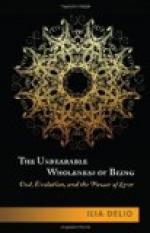The impulse and the strength necessary for the organisation of the Crusades were spiritual phenomena inherently foreign and even hostile to the Church; but thanks to the mental superiority of the popes of that period, and the overpowering conception of a divine kingdom, they became the instruments of the greatest triumphs vouchsafed to the Church of Rome. The hosts, driven across the sea by inner restlessness and ill-defined longing, in reality fought for the aggrandisement of the Church. The great Hildebrand resolved to lead all Christendom to Jerusalem, to found on the site of the Holy Sepulchre the divine kingdom preached by St. Augustine, and invest—a risen Christ—the emperor and all the kings of the earth with their kingdoms.
The crusader and the knight in quest of the Holy Grail present together a paradoxical combination of the Christian-ecclesiastical and the mundane-chivalric spirit, which is quite in harmony with the spirit of the age. These two worlds, inward strangers, formed—in the Order of the Knight-Templars, for instance—a union which, while possessing all the external symbols of chivalry, attributed to it heterogeneous, ecclesiastical motives; the glory of battle and victory, the caprice of a beautiful damsel, were no longer to become the mainsprings of doughty exploits; henceforth the knight fought solely for the glory of God and the victory of Christianity. In addition to King Arthur’s knights, the classical Middle Ages worshipped the ideal of these priestly warriors who waded through streams of blood to kneel humbly at the grave of the Saviour, of those seekers of the Holy Grail who dedicated themselves to a metaphysical task. King Arthur’s Round Table served the actual orders of knighthood as a model. Not only the Franciscans of Italy, but also slow, German mystics, such as Suso and the profound Johannes Tauler, delighted in borrowing their similes and metaphors from knighthood. Tauler speaks of the “scarlet knightly robes” which Christ received for His “knightly devotion”: “And by His chivalric exploits he won those knightly weapons which he wears before the Father and the angelic knighthood. Therefore Christ exults when His knights elect also to put on such knightly garments ...,” etc.
Not infrequently the Saracens behaved far more generously than the Christian armies. A German chronicler, Albert von Stade, tells us that A.D. 1221 “the Sultan of Egypt of his own free will restored the Lord’s Cross, permitted the Christians to leave Egypt with all their belongings, and commanded all prisoners to be set free, so that at that time 30,000 captives were released. He also commanded his subjects to sell food to the rich and give alms to the poor and the sick.” Occasionally the pope entered into an alliance with the enemies of Christendom against the emperor, if the latter proved troublesome. A.D. 1246 the Sultan of Egypt (Malek as Saleh Ejul) taught Innocent IV., the speaker of all Christendom, the judge of the Christian peoples, the following lesson: “It is not befitting to us,” he wrote to him, “that we should make a treaty with the Christians without the counsel and consent of the emperor. And we have written to our ambassador at the court of the emperor, informing him of what has been proposed to us by the Pope’s nuncio, including your message and suggestions.”




